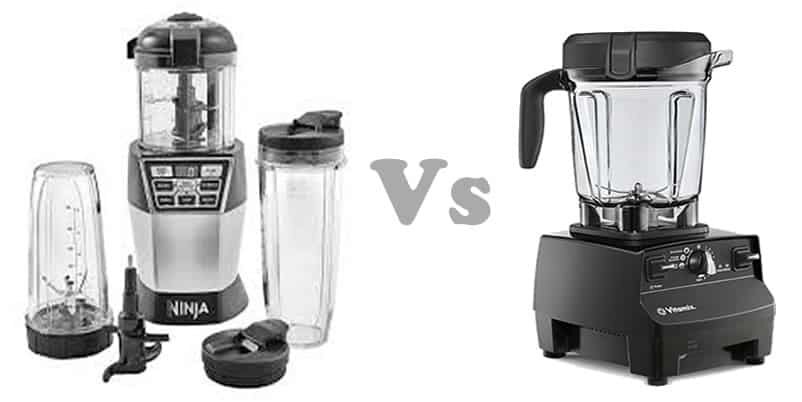Blenders can be used for various purposes at home. They mostly come in handy for people who love cooking. And while most of us would think a blender isn’t a necessity, some people would be lost without one.
Blenders help make your work easier in the kitchen. Whether you want to make your own fresh juice, smoothies or sauce, getting the perfect blender for your needs is something you can’t choose to turn a blind eye on. After all, your end product needs to be how you want it to be.
While buying a kitchen blender seems like an easy task, it isn’t. Of course, the market is saturated with various products from different manufacturers. And while you can purchase any blender, getting value for your money should be key for you. Remember, it’s an investment that you are making and one that should serve you well for at least a few years. So, what should you look for in a blender while buying one? Keep on reading as we compare Ninja vs Vitamix blenders.
Our Quick Comparison (Vitamix vs Ninja Blenders)


Vitamix Blenders
Check Price on Amazon


Ninja Blenders
Check Price on Amazon
What to Consider When Choosing Between The Two Blenders
There are several things that you should cross of your checklist before buying any of the two blenders.
Type of Blender
As mentioned earlier, blenders can be used for different purposes. There are those that can perform basic functions while there are others that are more versatile letting you blend hard food. While the more versatile blenders are costlier, they essentially would give you more freedom. Also, do you want a cordless or electric blender? These are some of the questions that can help you choose the type of blender to invest your money on.
Immersion or Countertops
Immersion blenders also are known as stick blenders, are small in size and are handheld blenders that have a rotating blade at the end of the stick. They’re designed to blend ingredients in bowls or glasses and are good for pureeing milkshakes, sauce or froth. Countertop blenders, on the other hand, come with a large jar that’s attached to the stand and has the blender controls. Ideally, countertop blenders are meant for your countertop. When choosing which one to buy between the two, you need to consider your kitchen’s countertop space and the purpose that you would want the blender to serve.
Motor Horsepower/Wattage
Blenders were created for the purposes of blending. A blender’s horsepower should be a key consideration for you when buying one. Blenders have two different horsepower; maximum and rated horsepower. That horsepower that arises when you turn on the blender is known as maximum horsepower while the stable horsepower the blender’s motor can sustain is known as the rated horsepower. When buying a blender, look at its wattage as that will help you know how sturdy the motor is.
Blender Controls
Different blenders have different blending control options. While others may come with three speeds only, others will have crushed, smoothie, puree and blend options among others. Depending on your needs, choosing which control options you need is a task you will have to handle by yourself. Moreover, their microprocessor blenders and manual control blenders. With the latter, you will need to press the buttons to change the speed while the microprocessors have blend cycles that are programmed and don’t need lots of attention.
Jar Material
Three main jar materials are usually used when designing blenders; glass, stainless steel and plastic (polycarbonate). All the three have their own pros and cons. Glass blenders are easy to clean but heavy. Also, if it accidentally slips from your hand, you will need to buy another one if it breaks. Stainless steel blenders are light but make it difficult for you to see the inside when blending. Plastic blenders are light, easy to clean and can survive a couple of falls. However, they tend to keep the smell.
Use and Budget
Depending on how often you intend to use your blender, you need to consider the quality. If it’s every other week, an expensive model will do you good. While at it, also think of the budget you have in mind vis-à-vis what the market offers. Listing down the features you want in a blender can help you in budgeting.
What’s the Difference (Vitamix vs Ninja) Blenders?
There are a variety of blenders available on the market today. For purposes of this review, we chose to focus on two of the most popular blender products in the market; the Vitamix and the Ninja.
Most people who want a sturdy and sizeable blender always opt for either of the two. Although from different brands, both blenders have powerful blades that crush ice in a matter of seconds. Still, they are both easy to clean and maintain.
Below are some of the features we looked at when testing the blenders form the two blender lines in our review.
Blending Capability
Both the Vitamix and Ninja brands are quite powerful when used to blend solids like seeds, ice, vegetables as well as fruits. They are both able to blend both vegetables and fruits, crush ice and still make you a nice drink. However, for a more professional cook who prepares, cooks and serves various meals and drinks, there are a couple of differences when differentiating between the two.
The wattage or horsepower of the Vitamix line of blenders is at 1380 watts. On the other hand, depending on the Ninja line of blenders models, their watts range between 1000 and 1500. In terms of raw power, Vitamix takes the crown. While the Vitamix blender easily blends and crushes frozen foods, the Ninja blenders have a bit of difficulty. The ninja blender is ideal for the softer foodstuff.
AVAILABILITY OF CONTAINERS
Both the Vitamix and Ninja line of blenders have different options for container size. The manufacturers of both brands also use free BPA plastic material in their design. This is important as Bisphenol A (BPA), is a dangerous chemical for the well-being of people. As such, it’s important to choose a blender that is BPA – free.
When choosing between these two powerful blenders, it’s important to factor in the types of containers that can be bought for either blenders. This is essentially important if you are blending for more people. Below are the available container types for both the Ninja and the Vitamix blenders.
Ninja line container options include 72-ounce pitches, 40-ounce bowl, and single serving cups. Vitamix line container options include a 64-ounce container (both standard and low profile), 48-ounce container, 32-ounce container and 32-ounce dry grains container.
Ease of Use
No one wants to invest their money into buying a kitchen accessory that will need plenty of time in getting used to. Ease of use is especially important when it comes to blenders.
The control options for Vitamix are simpler than those of the Ninja. However, that doesn’t mean it lacks power. Compared with Ninja, Vitamix’s power is higher. Vitamix blenders also come with a Hi/Low switch and have a tamper that comes in handy when blending both frozen and solid foods.
When it comes to speed, the Ninja line of blenders has three sets combined with a pulse button. This gives you more control when it comes to how well blended you want your entrees or food stuff. While the Ninja has good speeds, the blade tower available in its line of blenders makes it difficult to taste whatever one is blending. If need be, use a spoon instead of your finger. The Ninja has a suction cup feature on the blender’s base know as Lock-In Lever that helps prevent the blender from moving when thick materials such as dough are being blended.
Even with the Lock-in Lever, Vitamix still takes the crown when it comes to ease of use.
Cleaning
Although both blenders are quite easy to clean, the Vitamix blender differs a bit from other blender lines. Vitamix’s blades that are at the bottom can’t be easily removed. When it comes to cleaning, once has to put detergent and pour warm water into it and leave to blend for about 10 to 15 seconds.
Once cleaned, you will need to thoroughly dry the blender to keep it from developing smells. On the other hand, cleaning the Ninja blender is quite easy. Although it can be cleaned through the same process, the Ninja’s blades can easily be removed and cleaned separately. This makes it much faster and easier to clean than the Vitamix line of blenders. When cleaning the Ninja blenders, be careful of the blades.
Overall, in ease of cleaning, the Ninja line of blenders outdo the Vitamix blenders.
Also Read: Magic Bullet vs Nutribullet
Conclusion
The (vitamix vs ninja) line of blenders are both quality blenders and are worthy investments. Both line of blenders, if well used and maintained, can serve you for a couple of years before the need to buy another blender arises. While Vitamix blenders are pricier with price ranges of between 300 to 700 dollars, the Ninja blenders are more affordable with starting price points of about 130 dollars.
>>>>My personal favorite is the Vitamix 5200 Blender Professional-Grade <<<<
While the Vitamix blenders are sturdier and a great choice for frequent use, Ninja blenders will give you less cleaning hassle. However, choosing a blender depends on an individual’s own specific need. Know the features you want in your blender and opt for one that has at least all of them if not all.


Hello, I’m Scott – a juicer and blending enthusiast. I hope to inspire you to make one positive step towards your juicing or blending journey through visiting this site.
We’ll go over some easy tips, guides, hacks, and honest product reviews so that you don’t have to waste your time or money on trial and error.

